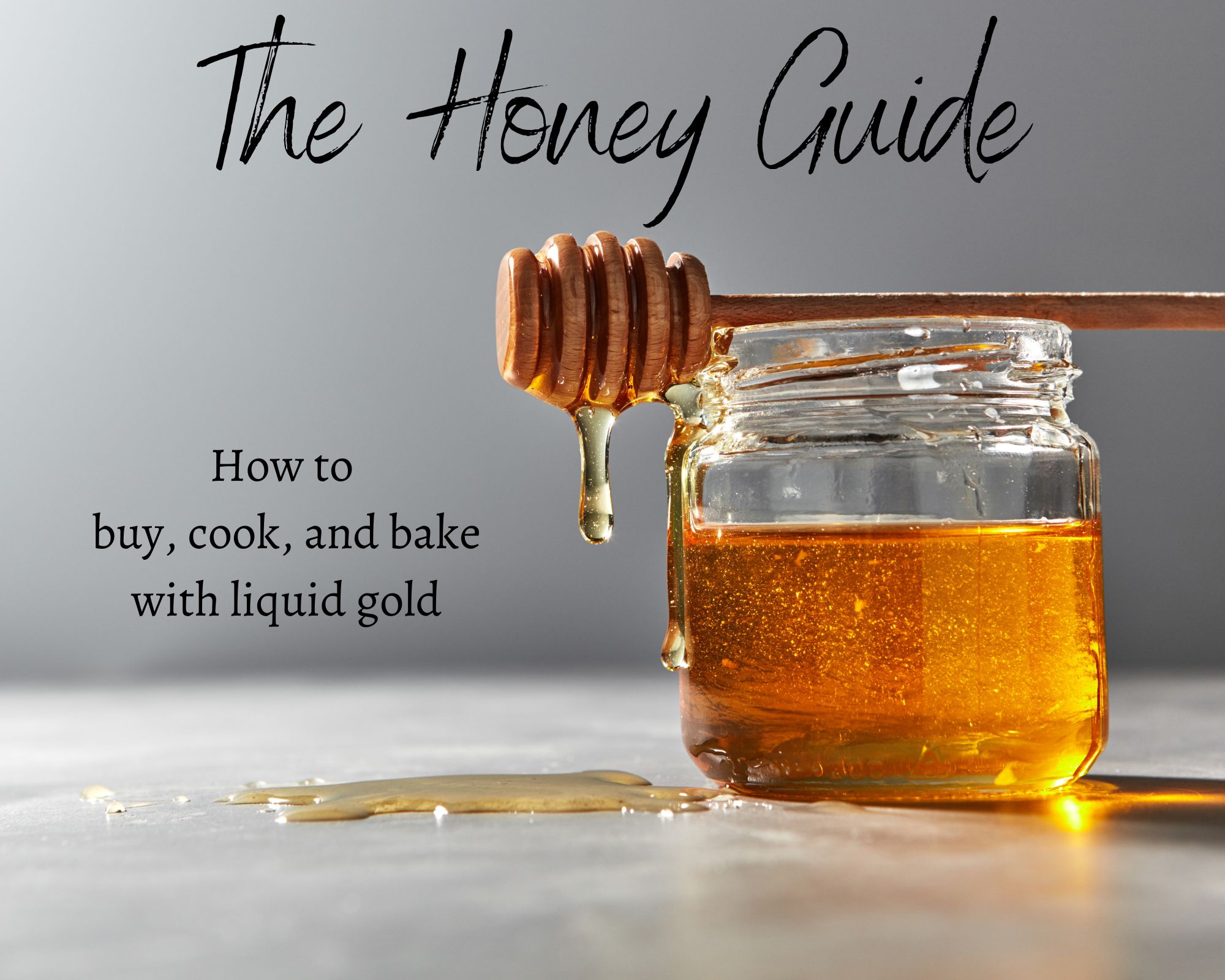The Honey Guide: How to Buy, Cook, and Bake with Liquid Gold
Honey has been cherished for its sweetness and versatility for centuries. From its ancient roots in medicinal practices to a prominent place in modern cuisine, honey continues to captivate taste buds and offer a variety of culinary possibilities. Here, our kitchen team will outline the various types of honey, what to look for in buying honey, and offer creative ways to incorporate this delicious liquid gold into your cooking and baking.
Tips for Buying Honey
When it comes to buying honey, quality is important. Here are some tips to ensure you’re getting the best honey for your culinary adventures:
Look for Raw and Unfiltered Honey
Raw honey retains more of its natural flavor and beneficial nutrients compared to processed varieties. Unfiltered honey contains particles of pollen and beeswax, enhancing both flavor and texture. It the best because it’s the least processed.
Check the Source
Opt for locally produced honey whenever possible. Not only does this support local beekeepers and sustainable agriculture, but it also ensures fresher honey with unique flavor profiles reflective of your region. It also contains the pollen specific to your location, which can be beneficial for treating pollen allergies!
Read the Label
Pay attention to labels that indicate the honey’s origin, whether it’s wildflower, clover, or a specific floral source. Different sources of pollen mean different flavors of honey! Additionally, certifications such as organic or fair trade can provide assurance of quality and ethical sourcing practices.
Consider the Color and Consistency
Honey comes in various shades, from light amber to dark amber, each with its distinct flavor profile. While lighter honeys tend to have milder flavors, darker ones offer more robust, caramel-like notes. The consistency can range from thin and runny to thick and creamy, depending on factors like floral source and processing.
The Different Types of Honey
Honey varieties extend beyond just flavor and color; it also varies based on the floral sources visited by bees. Here are some of the common types of honey:
Wildflower Honey
Made from nectar collected from a variety of wildflowers, this type of honey boasts a complex flavor profile with hints of different floral notes.
Orange Blossom Honey
This bright, citrusy flavored honey is commonly found in the southern states of the US where oranges are being grown. The flavor is delicate with a fruity, citrus flavor profile. Because of its subtle citrus notes, this honey is particularly good stirred into drinks and iced teas.
Clover Honey
The most commonly found honey variety, it is derived primarily from clover blossoms. This honey is known for its mild, sweet taste and light color, making it a versatile choice for cooking and baking.
Manuka Honey
Hailing from New Zealand, Manuka honey is celebrated for its robust flavor and purported health benefits, attributed to its high levels of antibacterial properties.
Acacia Honey
With its light color and delicate floral aroma, acacia honey is prized for its subtle sweetness and smooth texture, making it ideal for drizzling over desserts or pairing with cheese.
Cooking and Baking with Honey
Here are some friendly tips for incorporating honey into your cooking and baking:
Sweetening and Flavoring
Honey serves as a natural sweetener and imparts a distinctive flavor to dishes. Substitute honey for sugar in recipes, keeping in mind that it’s sweeter than sugar, so you may need to adjust the quantity accordingly. Experiment with different types of honey to explore their unique flavor profiles and how they complement various ingredients. Think honey in your herbal tea!
Marinades and Sauces
Create flavorful marinades and sauces by combining honey with ingredients such as soy sauce, citrus juice, herbs, and spices. The natural sugars in honey caramelize when exposed to heat, imparting a rich depth of flavor and glossy finish to meats, vegetables, and seafood when cooked. It’s also the perfect sweetener for sauces to serve alongside meat, seafood and vegetable dishes. Stir a little honey into a butter sauce, chutney, or gravy and enjoy a deliciously balanced sauce for your meal.
Baking with Honey
Incorporating honey into baked goods adds moisture, flavor, and a subtle sweetness. It pairs exceptionally well with ingredients like oats, nuts, fruits, and spices in cookies, cakes, bread, and granola bars. Try using honey in banana bread, oatmeal cookies, or your favorite muffin.
When substituting honey for sugar in baking perform the following three adjustments:
1 – Reduce the amount of sweetener in the recipe by about 1/4 cup for every 1 cup of sugar listed (for example, if the recipe calls for 1 cup sugar, you will use 3/4 cup honey).
2 – Reduce the amount of liquid by 1/4 cup (if the recipe calls for 1 cup milk, oil, or water, reduce the amount to 3/4 cup or 1/4 less than the amount listed).
3 – Lower the baking temperature by 25 degrees F to prevent excessive browning due to the honey’s higher moisture content.
Balancing Flavors
Keep in mind that honey has its own distinct flavor profile, so adjust the amount used in recipes to achieve the desired level of sweetness and flavor without overpowering other ingredients. Taste as you go and make adjustments accordingly to achieve your culinary harmony.
Honey has been used in the kitchen and beyond for most of human history, which is why it is such a wonderful addition to your pantry. Whether drizzled over yogurt, stirred into tea, or infused into savory dishes, its versatility knows no bounds. Now that you have a better understanding of the possibilities for uses of honey, and the varieties that can be found, we hope you’ll try using honey in your own kitchen. So go ahead, embrace the golden goodness of honey, and let your culinary imagination run wild.
